Accuracy is priority number one.
All grades come from the software's analysis of the uploaded image and there is no human analysis involved.
The overall grade and each subgrade strictly follow the standards listed below...
| 1 | Grades are between 10 and 1, where 10 is the best and 1 is the worse, and they move down by "½ point" increments (10, 9.5, 9.0, 8.5, etc...). So this means there are 19 possible grades. |
| 2 | There is 1 overall grade and 4 subgrades. The overall grade is the average of the subgrades. |
| 3 | Each subgrade is based on measurements, like pixels or degrees, of the card. And a meaningful range of measurements is established for each subgrade. |
| 4 | The range of measurements is then divided by 19 which results in ½ point deduction amounts |
| 5 | Subtracting ½ point deduction amounts starts at 10 and if the deductions result in a grade less than 1 then the the grade will be rounded up tp 1. |
| 6 | Grades are rounded to the nearest ½ point (.5 or 0). So a grade of 9.1 will be rounded down to a 9, a grade of 9.3 will be rounded to 9.5 and a grade of 9.8 will be rounded to a 10. |
Specifics about the overall grade and each subgrade is listed below...
| 1 | In certain situations, the software may not be able to identify the boundaries of the image at the center of the card. In those cases the rotation and centering subgrades will be "undetermined" and will not be part of the overall grade. |
| 2 | All the determined subgrade are added together, divided by the number of determined subgrades |
| Most cards are rotated alittle. The vast majority of images are rotated between 0 to 2.0 degrees from the card's edge. The worst I've seen is 2.6 degrees. |
| Most cards are not perfectly square. So the angle of rotation of an image's side to its closest edge may be different for each side. |
| So to have the most accurate rotation grade the following steps have been taken… |
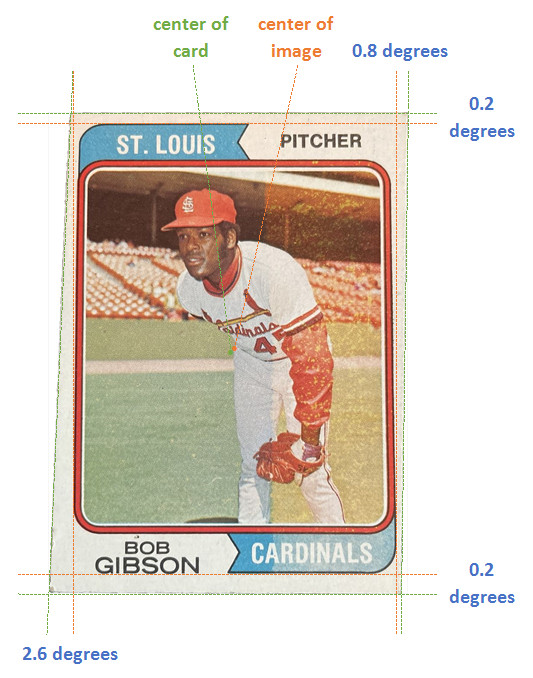
| 1 | Since the vast majority of cards are rotated no more than 2.0 degrees, a meaningful range of rotation grades that also provides a convient number to work with is a range of 0 degrees to 1.8 degrees. Which means that for each .1 degrees of rotation a ½ point is subtracted from the rotation grade (see Rotation grades table). |
| 2 | Since each sides angle of rotation may differ, all 4 sides are measured and 4 rotation grades are created. |
| 3 | All 4 rotation grades are added together, divided by 4 which results in the subgrade rotation. |
| 4 | If the software can not identify the boundaries of the image then the rotation subgrade is "undetermined" and will not be part of the overall grade. |
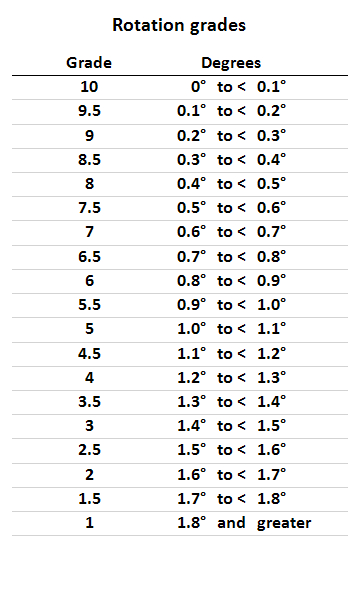
| Since card and image sizes vary from year to year as well as from manufacturers, calculating the percentage of how close the image center is to the card center is the most accurate way to proceed. And both PSA and Beckett standards use percentage for centering too. |
| The centering of an image on a card depends on how far away the center of the image is from the center of the card, the size of the card and the size of the image. |
| So to have the most accurate centering grade the following steps have been taken… |
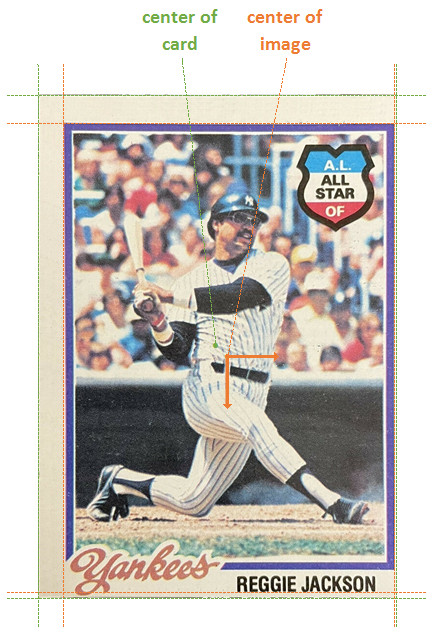
| 1 | A meaningful range of centering grades that also provides a convient number to work with is when the card's image is centered in the middle of the card, the percentage is 100%. And when the card's image is justified to one side the percentage is 0%. Which means that for each 5% away from the center a ½ point is subtracted from the centering grade (See "Centering grades" table). |
| 2 | Since each card's image can be centered/justified in 2 directions (left or right and top or bottom), both directions are measured and 2 centering grades created. |
| 3 | Both centering grades are added together, divided by 2 which results in the centering subgrade. |
| 4 | If the software can not identify the boundaries of the image then the centering subgrade is "undetermined" and will not be part of the overall grade. |
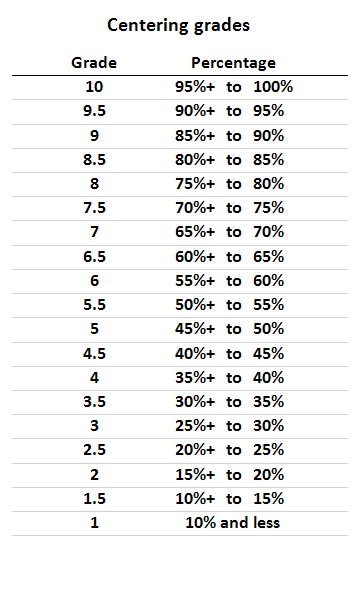
| Squareness is how close adjacent sides are to 90 degrees (a perfect right angle). |
| Most cards adjacent sides are within +/- .5 degrees of 90 degrees. Trimming a card could create an angle that is further away from 90 degrees. |
| So to have the most accurate squareness grade the following steps have been taken… |

| 1 | Since most card's adjacent sides are +/- .5 degrees of a perfect 90 degrees, a meaningful range would be to consider angles between 89.5 degree to 90.5 degrees a 10. And then subtract a ½ point for every .5 degrees further away from 90 degrees (see Squareness grades table). |
| 2 | There are 4 sides and each could have a different angle with its adjacent side. So to be most accurate all 4 angles are meaured and assigned a grade. |
| 3 | All 4 squareness grades are added together, divided by 4 which results in the subgrade squareness. |
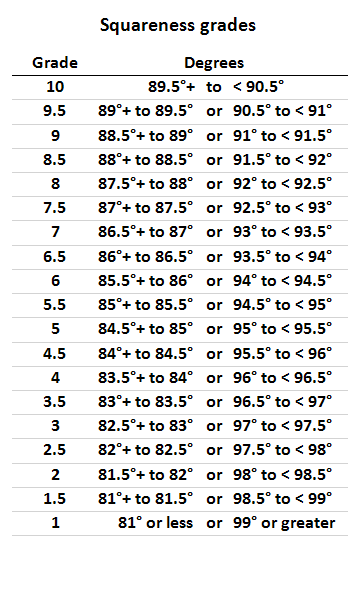
Coming soon